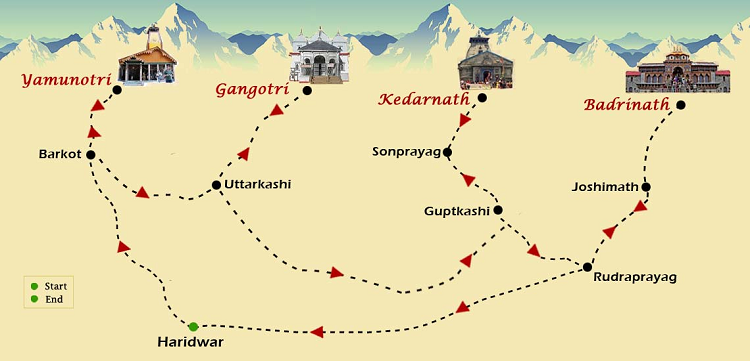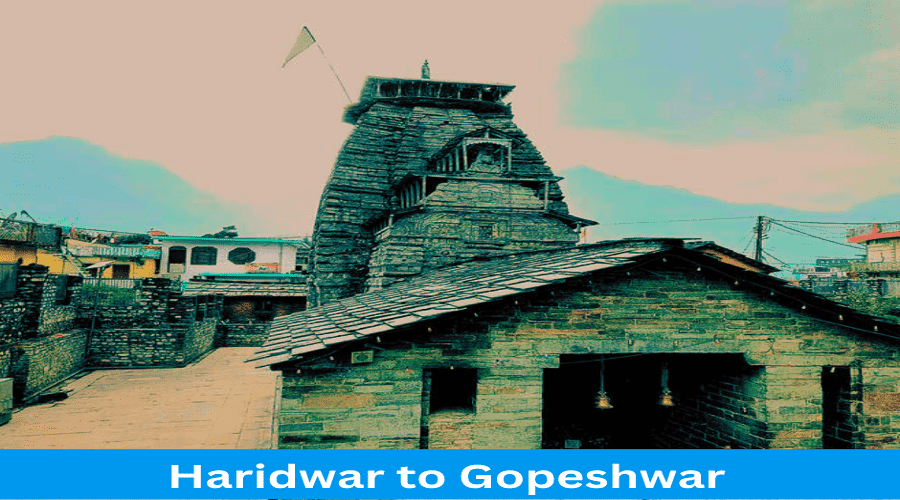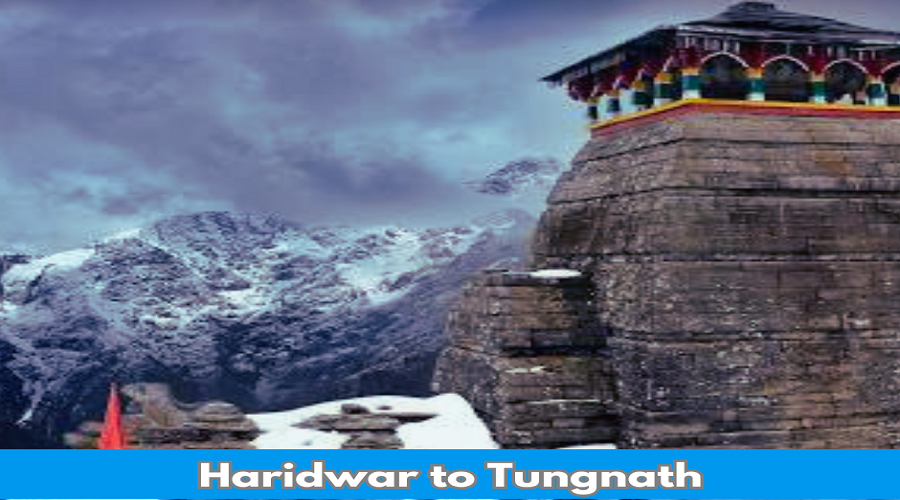Table of Contents
Toggle



Haridwar to Kedarnath Distance
The distance from Haridwar to Kedarnath is approximately 253 kilometers by road.
To travel from Haridwar to Kedarnath, you can follow these steps:
1. Haridwar to Rishikesh (24 km): Start your journey from Haridwar to Rishikesh. You can take a bus or a taxi to reach Rishikesh.
2. Rishikesh to Rudraprayag (141 km): From Rishikesh, you can take a bus or hire a taxi to reach Rudraprayag. The journey takes around 5-6 hours.
3. Rudraprayag to Gaurikund (74 km): From Rudraprayag, you need to travel to Gaurikund. You can hire a taxi or take a shared jeep to reach Gaurikund.
4. Gaurikund to Kedarnath (14 km trek): From Gaurikund, you have to trek 14 km to reach Kedarnath. The trek is moderately difficult and takes around 5-6 hours.
Alternatively, you can also hire a helicopter service from Phata or Sersi to Kedarnath, which reduces the travel time significantly. However, helicopter services are subject to weather conditions and availability
How far is Kedarnath from Haridwar by Road or Helicopter
The distance from Haridwar to Kedarnath varies depending on the mode of transportation:
1. By Road: The road distance from Haridwar to Kedarnath is approximately 225 kilometers. The journey by road usually takes around 8 to 10 hours, depending on the traffic and road conditions.
2. By Helicopter: The aerial distance from Haridwar to Kedarnath is around 90 kilometers. Helicopter services are available from Phata, which is the nearest helipad to Kedarnath. The helicopter ride takes approximately 30 to 40 minutes, providing a faster and more convenient option compared to the road journey. However, helicopter services are subject to weather conditions and availability, so it’s advisable to check the schedule and book in advance.
Can we reach Kedarnath by Car

Yes, you can reach Kedarnath by car, but only up to a certain point. The road connectivity to Kedarnath is available only till Gaurikund. From Gaurikund, which is the base camp for the Kedarnath trek, you will need to either trek or use other means of transport like ponies or palanquins to reach Kedarnath Temple, which is about 16 kilometers away from Gaurikund.
Can we stay overnight in Kedarnath
Yes, you can stay overnight in Kedarnath. There are several accommodation options available in Kedarnath for pilgrims and tourists, including guesthouses, dharamshalas, and tents. It’s advisable to book your accommodation in advance, especially during the peak pilgrimage season, as the availability of rooms can be limited.
Guesthouse Near Kedarnath
There are several guesthouses near Kedarnath that offer accommodation for pilgrims and tourists. Some of the popular guesthouses include:
1. GMVN Tourist Rest House, Kedarnath: This is a government-run guesthouse offering basic accommodation facilities.
2. Kedarnath Uttarakhand Tourism Development Board (UTDB) Guest House: Another government-run guesthouse providing comfortable stay options.
3. Private Guesthouses: There are also several private guesthouses and lodges near Kedarnath that offer a range of accommodation options to suit different budgets and preferences.
It’s advisable to book your stay in advance, especially during the peak pilgrimage season, to ensure availability.
How to go Kedarnath by Train

To reach Kedarnath by train, you can take a train to the nearest railway station, which is Haridwar. From Haridwar, you will need to continue your journey by road. Here’s how you can do it:
1. Reach Haridwar: You can take a train to Haridwar from major cities like Delhi, Mumbai, Kolkata, etc. Haridwar is well-connected by rail to various parts of the country.
2. Travel from Haridwar to Kedarnath: From Haridwar, you can travel to Kedarnath by road. The road distance between Haridwar and Kedarnath is approximately 225 kilometers. You can take a bus, taxi, or hire a private vehicle to reach Gaurikund, which is the base camp for the trek to Kedarnath.
3. From Gaurikund to Kedarnath: From Gaurikund, you will need to trek or use other means of transport like ponies or palanquins to reach Kedarnath, which is about 16 kilometers away.
It’s important to note that there is no direct train connectivity to Kedarnath, and you will need to combine train and road travel to reach the pilgrimage site.
Best time to visit Kedarnath
The best time to visit Kedarnath is from May to June and September to October.
1. May to June: This is the peak season for visiting Kedarnath, as the weather is pleasant and suitable for trekking. The Kedarnath Temple is open for darshan during this time, and the surrounding area is in full bloom, offering a picturesque setting.
2. September to October: This is another good time to visit Kedarnath, as the weather is cool and the monsoon has passed, reducing the risk of landslides. The temple is also open for darshan during this period.
It’s advisable to avoid visiting Kedarnath during the monsoon season (July and August) due to the risk of heavy rainfall and landslides, which can make the trekking route unsafe. Additionally, the winter months (November to April) are also not recommended for visiting Kedarnath, as the region experiences heavy snowfall and the temple remains closed during this time.
Can I reach Kedarnath in One Day
Yes, it is possible to reach Kedarnath in one day, but it would require careful planning and an early start. Here is a general outline of how you can do it:
1. Start from Haridwar or Rishikesh
If you are starting from Haridwar or Rishikesh, you can take a taxi or bus to Gaurikund, which is the base camp for the trek to Kedarnath. The journey from Haridwar or Rishikesh to Gaurikund takes about 8 to 10 hours by road, depending on the traffic and road conditions.
Trek from Gaurikund to Kedarnath
Once you reach Gaurikund, you will need to trek or use other means of transport like ponies or palanquins to reach Kedarnath. The trek from Gaurikund to Kedarnath is about 16 kilometers long and usually takes around 6 to 8 hours, depending on your pace and the weather conditions.
3. Visit the Kedarnath Temple
After reaching Kedarnath, you can visit the Kedarnath Temple and pay your respects. The temple is one of the 12 Jyotirling and is a significant pilgrimage site for Hindus.
4. Return Journey
After visiting the temple, you can start your return journey to Haridwar or Rishikesh. It’s advisable to start early in the morning to ensure you have enough time to complete the journey safely and to avoid trekking in the dark.
While it is possible to reach Kedarnath in one day, it can be physically demanding, especially the trek from Gaurikund to Kedarnath. It’s important to be prepared and in good physical health before attempting this journey.
Which route is better for Kedarnath Yatra
There are two main routes to reach Kedarnath
1. Via Haridwar-Rishikesh-Rudraprayag-Gaurikund
This is the most common route taken by pilgrims and tourists. It involves traveling from Haridwar to Rishikesh, then to Rudraprayag, and finally to Gaurikund. From Gaurikund, you can trek or use other means of transport to reach Kedarnath.
2. Via Haridwar-Rishikesh-Sonprayag-Gaurikund
This route is similar to the first route but takes you through Sonprayag instead of Rudraprayag. The distance from Sonprayag to Gaurikund is shorter compared to the distance from Rudraprayag to Gaurikund, but the road conditions may vary.
Both routes offer scenic views and are well-connected by road. The choice of route depends on factors such as your starting point, road conditions, and personal preference. It’s advisable to check the latest road conditions and weather forecasts before deciding on a route.
What is the oxygen level in Kedarnath
The oxygen level in Kedarnath can vary depending on various factors such as altitude, weather conditions, and individual health. Kedarnath is located at an altitude of about 3,583 meters (11,755 feet), which is considered high altitude. At such altitudes, the oxygen levels are lower than at sea level, and some people may experience symptoms of altitude sickness such as shortness of breath, dizziness, and fatigue.
It’s important to acclimatize properly when traveling to high-altitude destinations like Kedarnath. This involves taking it easy for the first few days, staying hydrated, and avoiding alcohol and strenuous activity. If you experience severe symptoms of altitude sickness, it’s advisable to descend to a lower altitude and seek medical help if necessary.
While there is no specific data available for the oxygen levels in Kedarnath, it’s recommended to be prepared for high-altitude conditions and take necessary precautions to ensure a safe and enjoyable journey.
Which Trek is difficult Kedarnath or Vaishno Devi
Both Kedarnath and Vaishno Devi are popular pilgrimage destinations in India, but they differ in terms of difficulty level.
1. Kedarnath
The trek to Kedarnath Temple involves a distance of about 16 kilometers (one way) from Gaurikund, the base camp. The trek is uphill and can be challenging, especially for those not accustomed to trekking or high altitudes. The altitude of Kedarnath (3,583 meters or 11,755 feet) can also make it physically demanding, and visitors may experience symptoms of altitude sickness.
2. Vaishno Devi
The pilgrimage to the Vaishno Devi Temple in Jammu involves a trek of about 14 kilometers (one way) from Katra, the base camp. The trek is also uphill but is generally considered less challenging compared to the trek to Kedarnath. The path to Vaishno Devi is well-paved and has facilities like resting places, refreshment stalls, and pony and palanquin services to assist pilgrims.
In summary, while both pilgrimages involve trekking, the trek to Kedarnath is considered more difficult due to the higher altitude and potentially more strenuous terrain. However, the difficulty level can vary depending on individual fitness levels and acclimatization to high altitudes.
Cost of VIP Darshan ticket in Kedarnath
The cost of VIP Darshan ticket in Kedarnath can vary depending on the specific arrangements and facilities provided. Generally, the cost ranges from Rs. 1,100 to Rs. 3,000 per person. This VIP Darshan ticket allows for a quicker and more convenient darshan (visit) of the Kedarnath Temple, bypassing the regular queue. The ticket may include additional services or amenities such as priority entry, special seating arrangements, and assistance from temple staff. It’s advisable to check with the temple authorities or official websites for the latest information on VIP Darshan ticket prices and availability.
Kedarnath Shivling can touch by Pilgrims
No, pilgrims are not allowed to touch the main Kedarnath Shivling. The lingam is considered extremely sacred, and only the head priest of the temple, known as the Rawal, is allowed to perform abhishekam (ritual bathing) and offer prayers directly to the shivling. Pilgrims can offer their prayers from a designated area in the temple and receive blessings without touching the shivling.
Famous to buy in Kedarnath Temple
In Kedarnath, you can find a few items that are popular among pilgrims as souvenirs or offerings to the temple. Some of the items you can consider buying include
1. Prasad
Offerings such as dry fruits, sweets, and sacred items, are available for purchase as prasad. These are considered blessed and are often taken back home by pilgrims.
2. Rudraksha
Rudraksha beads are considered sacred in Hinduism and are believed to have spiritual and healing properties. You can find Rudraksha beads being sold in and around the temple area.
3. Idols and statues
Small idols and statues of Lord Shiva, Parvati, and other deities are available for purchase. These can be kept in homes or used for worship.
4. Clothes and shawls
Woolen clothes, shawls, and blankets are available for purchase, especially useful during the cold weather in the region.
5. Religious books
Books, CDs, and other materials related to Hindu mythology, prayers, and devotional songs are available for those interested in deepening their spiritual knowledge.
Which body part of Shiva is in Kedarnath
In Kedarnath, the Shivling (also spelled as linga) is worshipped as the main representation of Lord Shiva. The Shivling is a symbol of divine energy and is believed to be a manifestation of the formless Supreme Being. The Kedarnath Temple is one of the 12 Jyotirling, which are considered to be the most sacred abodes of Lord Shiva. The Jyotirling at Kedarnath is believed to be the hump of a bull, which is an iconic representation of Lord Shiva.
What is the dress code for Kedarnath
There is no specific dress code for visiting Kedarnath, but it is advisable to dress modestly and respectfully, especially when visiting religious sites. Here are some general guidelines:
1. Modest Clothing
Wear modest and respectful clothing that covers your shoulders, chest, and legs. Avoid wearing shorts, tank tops, and revealing clothing.
2. Warm Clothing
The weather in Kedarnath can be cold, especially in the mornings and evenings, so it’s advisable to carry warm clothing, even during the summer months.
3. Comfortable Footwear
Wear comfortable and sturdy footwear, especially if you plan to trek to Kedarnath from Gaurikund.
4. Cap & Scarf
It’s a good idea to carry a hat or scarf to protect yourself from the sun during the day and the cold at night.
5. Rain Gear
During the monsoon season, it’s advisable to carry a raincoat or umbrella as the weather can be unpredictable.
Overall, the key is to dress comfortably and respectfully, keeping in mind the weather conditions and the sanctity of the place.







